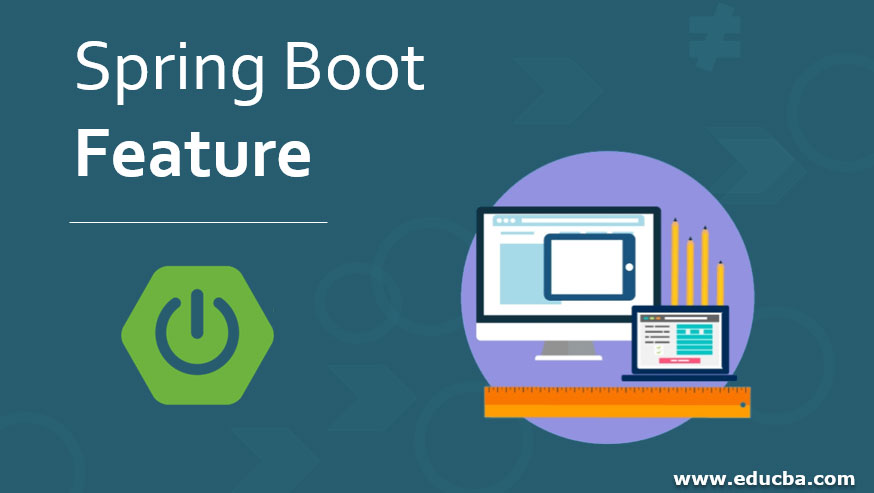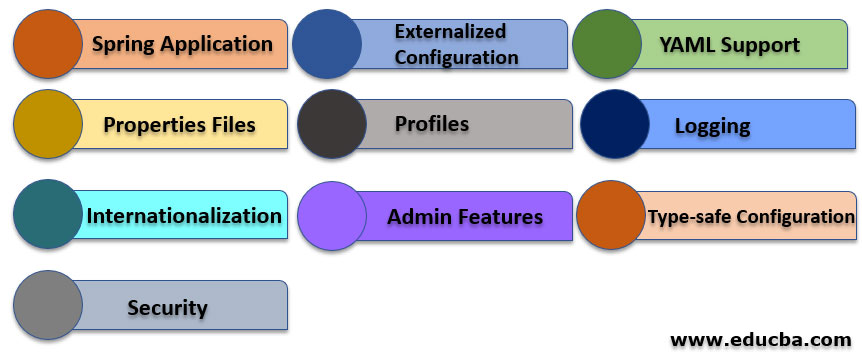Updated March 23, 2023

Overview of Spring Boot Feature
The software developer working with Spring Boot is very well versed with the magic power of Spring Boot and has the ability to create an application with minimal programming effort. In our earlier notes, we have taken a deep dive into what Spring boot is and the architecture of Spring Boot. So, now in this section, we would go through details of Spring Boot features. These features enable the programmer to write spring-based Java web applications by taking away all the frictions and pain in the coding and version controlling during the build of the spring applications.
Different Features of Spring Boot
Now, let’s get started on understanding what the problem is and then proceed to how the problem is tackled by our features in spring boot and then will look into a deep dive of each and every feature later on in the section. Now one would be asking why do we need to know the problem? Understanding the problem will help you taste the solution with more pleasure as it is said that “Fruits of knowing what hard work is, is sweeter than nectars”.
When a developer uses Spring, one can easily get away with the boilerplate codes, but in the process of accomplishing the functionality imported from other code, everything in the code needs to be compatible which becomes a huge task for the developer. Thus, to solve this cumbersome process of fixing the compatibility issues we have features in Spring Boot to take care of it.
Now let us look into the different features in Spring Boot:
1. Spring Application
This is a class in Spring Boot which enables the developer with a convenient way of bootstrapping a spring application by starting it from the main method. Many a time using the .run() method will enable the application to run.
2. Externalized Configuration
Using this feature enables the developer to work with the same application in different environments. From properties files, YAML files environmental variables arguments are taken to use directly to the beans either by @Value annotation or use @ConfigurationProperties for bounding to structured objects.
3. YAML Support
As we talked about the usage of YAML files for externalized configuration, Spring Boot does provide the flexibility of YAML support for specifying the hierarchical configuration.
4. Properties Files
YAML support as we discussed above is a successful alternative of properties files. Properties files are nothing but a text consisting of a set of properties needed for the application to run. For example, using server-port = 8080 means that the port used for running the server is 8080.
5. Profiles
By using profiling one can segregate different parts of the application and make it available to different environments as per requirement. Usage of spring.profiles.active={EnvironmentName} makes it available to only mentioned profiles. The parts which need to be limited have to be annotated using @Profile.
6. Logging
In Spring Boot “Commons Logging” is used for all internal logging. Generally, this part of the features remains vastly unchanged until and unless customization is explicitly needed.
7. Internationalization
Using this feature Spring Boot is capable of catering to users of different language preferences. The presence of a messages resource bundle in the root of the classpath is looked for by Spring Boot.
8. Admin Features
This feature in Spring Boot enables the user to have specific admin-related features for the application. Accessing and managing application can be performed remotely. One can use spring.application.admin.enabled property to enable such admin-related features.
9. Type-safe Configuration
Using @Value(“${property}”) annotation can be cumbersome when one is dealing with multiple properties or maybe the data is hierarchical in nature. Spring Boot provides type-safe configurations to counter this type of situation.
10. Security
When Spring Security is enabled in the classpath the web applications are secured by default. The content negotiation strategy of Spring Boot determines the usage of httpBasic or formLogin as per the requirement.
Conclusion
Lastly, we have had a chance to look at how the spring boot application works with the help of a simple example. It looks like a magic show that by using some annotations we can build an application without thinking about the infrastructure development behind it. It looks like a robot sitting behind an annotation and performs not only the required task but assumes things for us in case we deliberately or by mistakenly forgot to mention about the configuration. Just use some starter dependencies, annotate useful terms and let the magic begin from there. It is a very useful tool for standardizing the collection of tools and makes your programming life simple and painless!
Recommended Articles
This is a guide to Spring Boot Feature. Here we discuss the features of spring boot such as spring application, externalized configuration, YAML support, and properties Files, etc. You can also go through our suggested articles to learn more –

